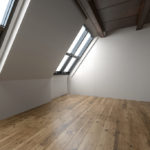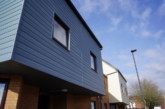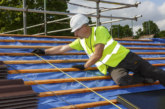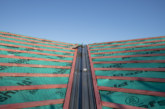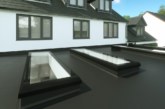Nick King, Area Account Manager at Klober, discusses the considerations that housebuilders should take into account when choosing an efficient solution for low pitch roofing applications.
Housebuilders can raise the roofing standard by prioritising low pitch specific roofing application products, including low pitch membranes. When the right membrane solution is chosen, a low pitch roof can be constructed without concern for future performance. Simultaneously, developers have the design freedom of specifying their preferred choice of roof covering below its recommended minimum pitch.
Low pitch roofing
When managing the development of new build projects, housebuilders will need to consider practical and financial factors. The good news is that opting for a low pitch roof helps to satisfy savings on the upfront material costs and reduces the installation time, when compared to other methods.
For a low pitch roof however, a high-quality membrane solution is the key to safeguarding any roofing investment.
Innovation
The latest low pitch innovations have seen Klober develop a membrane that is capable of serving as a primary barrier, as long as it is covered by a UV stable covering, such as slate or tiles. While other low pitch weathering options do exist, these are generally more costly and time consuming in comparison with a specific low pitch membrane (a membrane will need to be installed in most situations anyway).
Alternatively, some systems are available that incorporate weathering devices which need to be installed underneath every single tile or slate. However, these options often have to be installed alongside the manufacturer specific membrane as mandatory, which decreases flexibility and limits the product choices.
Over the years, membranes have become more technical and specific in design. This is especially true for low pitch applications that need specific membrane solutions to succeed or will otherwise fail.
To solve the challenges that low pitch roofing present, the development of Klober’s Permo Extreme delivers a solution where other membranes can’t and caters for pitches as low as 12.5º for interlocking tiles, 15º for slates and 22.5º for plain tiles. Permo Extreme is also much stronger than the average underlay on the market, in order to greatly reduce the risk of ripping and tearing whilst installation takes place.
To complement the strides taken to improve membranes, significant investments have been made into the development of accessories such as membrane tapes, and this has also improved roofing performance. Klober’s Permo Extreme is an example of this, as it comes with double, self-adhesive strips to provide a guaranteed permanent seal of overlaps, and in the case of Klober’s Butylon tape should also be used to seal around any batten nail penetrations. It is important to choose wisely and recognise that not all tapes are made equally. Failure to use tapes compatible with the chosen membrane can lead to subsequent failures.
Why membranes matter
Choosing the correct membrane cannot be underestimated, as even with all the right precautions taken in terms of water drainage, low pitch applications still present unique challenges.
When the correct products have been chosen, developers can trust that performance won’t be compromised. With the help of manufacturers who continue to innovate membrane performance and target specific project applications, housebuilders and property developers can be supported with the most up to date roofing product solutions.

